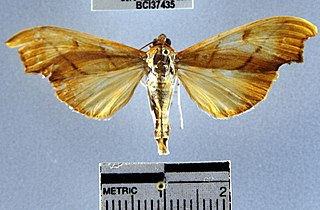
The Pyraloidea are a moth superfamily containing about 16,000 described species worldwide, and probably at least as many more remain to be described. They are generally fairly small moths, and as such, they have been traditionally associated with the paraphyletic Microlepidoptera.
Evergestella is a genus of moths of the family Crambidae. It contains only one species, Evergestella evincalis, which is found in Florida, as well as on the Cayman Islands, Cuba, Puerto Rico and Jamaica.

Sparagmia is a monotypic moth genus of the family Crambidae described by Achille Guenée in 1854. Its only species, Sparagmia gonoptera, described by Pierre André Latreille in 1828, is found in Central and South America and in the Antilles. Records include Argentina, Brazil, Panama, Costa Rica, Puerto Rico, Cuba and Jamaica.
Macalla phaeobasalis is a species of snout moth in the genus Macalla. It was described by George Hampson in 1916 and is known from Cuba, Jamaica and Florida.
Parapediasia ligonellus is a moth in the family Crambidae. It was described by Zeller in 1881. It is found in Jamaica, Cuba and Puerto Rico. It is also found in southern Florida.
Trischistognatha pyrenealis is a moth in the family Crambidae. It was described by Francis Walker in 1859. It is found in Mexico, Central America, the West Indies and the southeastern United States, where it has been recorded from Georgia to Florida and from Alabama to Texas.

Chalcoela pegasalis, the wasp parasitizer moth, is a moth in the family Crambidae. It was described by Francis Walker in 1859. It is found in Cuba, Jamaica, the French Antilles, Puerto Rico and also the United States and Canada.
Glaphyria bilinealis is a moth in the family Crambidae. It is found in Cuba, Jamaica, Puerto Rico and on the Virgin Islands.
Pyrausta carnifex is a moth in the family Crambidae. It was described by Cajetan von Felder, Rudolf Felder and Alois Friedrich Rogenhofer in 1875. It is found on Hispaniola, Jamaica and the Virgin Islands.
Bicilia olivia is a species of moth in the family Crambidae. It was described by Arthur Gardiner Butler in 1878. It is found on Jamaica.
Microthyris lelex is a moth in the family Crambidae. It was described by Pieter Cramer in 1777. It is widespread in the Caribbean, Central America and northern South America. Records include Suriname, Puerto Rico and Jamaica. It has recently been recorded from southern Florida.
Desmia deploralis, the deploring desmia moth, is a moth in the family Crambidae. It was described by George Hampson in 1912. It is found in Paraguay, Cuba, Jamaica and Florida.

Desmia ufeus is a moth in the family Crambidae. It was described by Pieter Cramer in 1777. It is found in Suriname, French Guiana, Costa Rica, Mexico, the Dominican Republic, Puerto Rico, Jamaica, Cuba and Florida.
Eulepte inguinalis is a moth in the family Crambidae. It was described by Achille Guenée in 1854. It is found in Brazil, French Guiana and in Jamaica, Cuba and Puerto Rico.
Microphysetica hermeasalis is a moth from the family Crambidae. The moth was discovered by Francis Walker in 1859, and it is found in Venezuela, Mexico, Central America, the Antilles and Florida. Its wingspan is 9–10 mm. Adults are on wing from March to June and from November to December in Florida.
Penestola bufalis, the black penestola moth, is a moth in the family Crambidae. It was described by Achille Guenée in 1854. It is found in the US states of Texas and Florida, as well as on the Antilles. It is an accidentally introduced species on the Galápagos Islands. The habitat consists of coastal mangrove swamps and shorelines.
Samea carettalis is a moth in the family Crambidae. It is found in Jamaica, Puerto Rico and Cuba.
Sathria simmialis is a species of moth in the family Crambidae. It is found in Jamaica, the Grenadines, Nevis, Saint Martin, Saint Kitts, Guadeloupe, Dominica and Grenada.
Steniodes gelliasalis is a moth in the family Crambidae. It was described by Francis Walker in 1859. It is found in Brazil, Colombia and the West Indies, where it has been recorded from Jamaica.
Syllepis marialis is a moth in the family Crambidae. It was described by Poey in 1832. It is found in Cuba, Jamaica, Puerto Rico, the Bahamas and Costa Rica.



